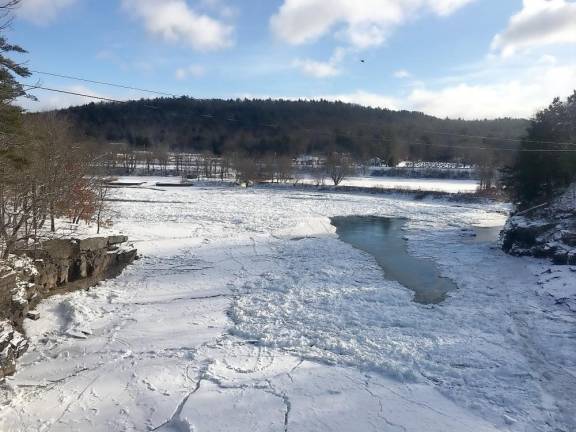Safety strategies for ice fishing on the Delaware
Beach Lake. The National Park Service advises: Wear a life jacket. Make sure the ice is thick enough. Know how to help someone who falls in and how to get out of the water yourself. Watch out for frost bite.

Anglers anticipate this time of year, when they can go ice fishing. The National Park Service would like to remind everyone of a few safety precautions to follow while out on the ice this season. One of the most important things to remember is the mandatory cold weather life jacket wearing regulation that is in effect through April 30, 2023. Regardless of age, everyone must be wearing a properly fitted and fastened life jacket while boating on the Upper Delaware River this winter.
While ice fishing on the river, it is strongly recommended and advised that everyone wear a life jacket.
As with any activity, safety is key, so be sure to check the ice frequently as you venture out. Ice thickness and condition are the main safety concern. Most water bodies do not freeze evenly. A minimum of 4 inches of solid (clear) ice or 8 inches of white or “snow ice” (which is half as strong as clear ice) is the general rule for safely walking on the ice. If you are unsure of the ice thickness, drill regular test holes as you go, at least every 150 feet.
Always avoid ice near moving or open water and areas that have feeder streams or springs. Also avoid dark, honeycombed or porous ice. Always let someone know where you will be fishing and when you plan to return. For adults, fishing with a friend is a good idea. Children should always be accompanied by an adult. Using good judgment is essential.
If you should happen to fall through the ice, don’t panic. Remain calm. Use ice safety picks (two handles with spike points) to help you get out of the water if you break through the ice. Ice picks can be purchased, or you can make your own with dowels and nails. If you don’t have ice picks, try “swimming out” which lets your body rise and allows you to get onto firm ice. Use your legs to kick behind you to keep from being pulled under.
If you can’t get to safety, call for help. Slip your “loose boots” off to make treading water easier. Keep your clothes on because they will insulate you from the cold water. Once on the ice, stay low and distribute your weight over as much surface area as possible. If someone else falls in, always remember to use Reach (long stick, fishing pole), Throw (rope, PFD, anything that floats), Row (row or push a boat), Go (call for help).
If you become wet, immediately change into dry clothes, and seek warm shelter. If you feel cold, it’s because you are cold. Watch out for frostbite (pale skin on exposed flesh). Treat it with warm water. Watch out for hypothermia (shivering, loss of judgement). Treat it with warm fluids, dry clothes, a blanket and warm shelter. Stop ice fishing if you become tired or cold.